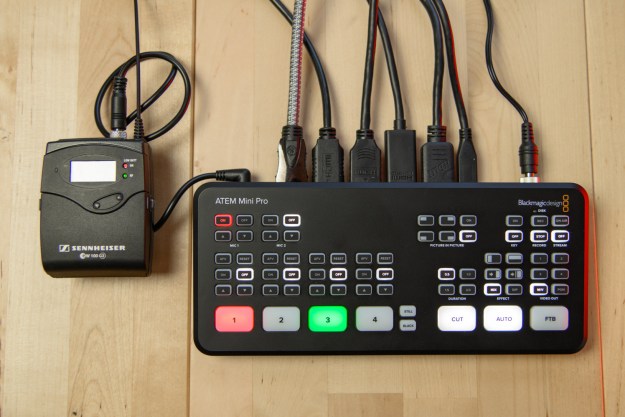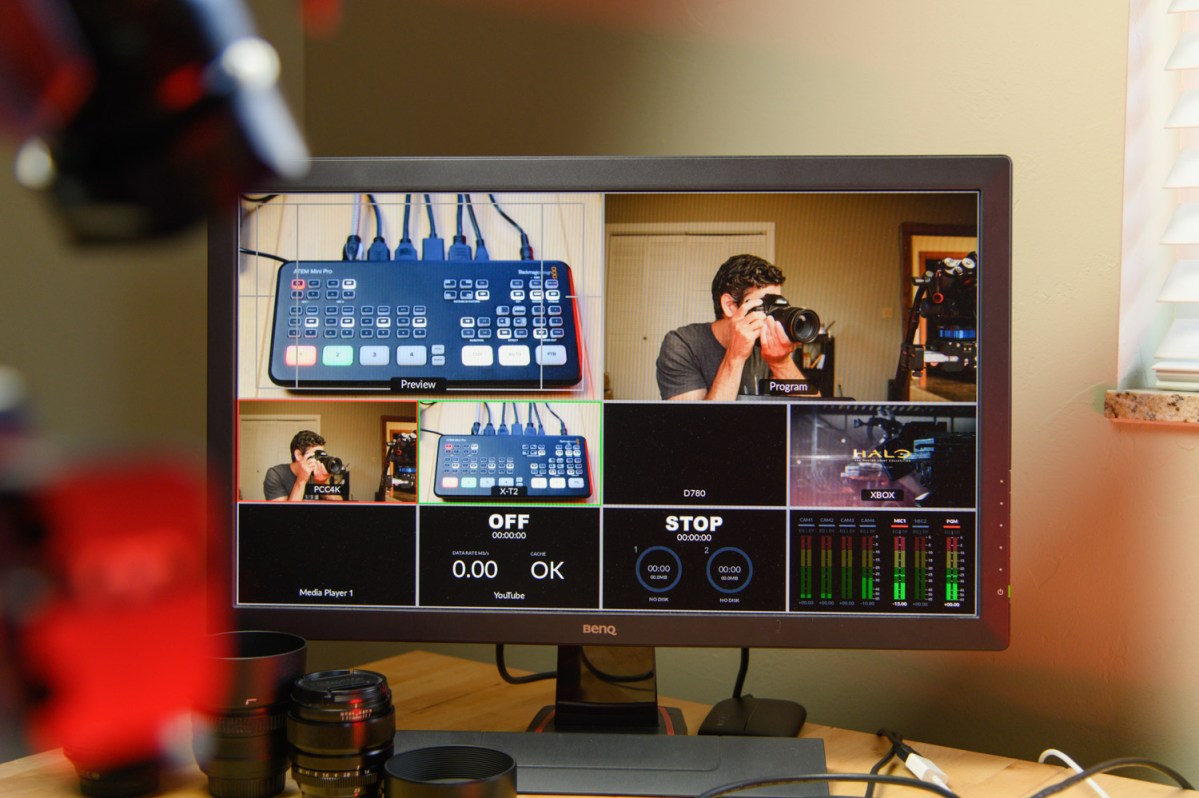
“The ATEM Mini Pro is your ticket to professional-grade Zoom meetings, and an awesome tool for streamers on all platforms.”
- Very simple to set up
- Incredibly powerful
- No driver required for most features
- Low-latency HDMI output for gaming
- No 4K support
Hold back that yawn! An HDMI switcher might not sound exciting, but Blackmagic Design’s ATEM Mini Pro is the most fun I’ve had with a tech product this year. Designed by a company that builds expensive, rack-mountable thingamajigs for broadcasters, this is an affordable multi-camera streaming solution for the rest of us. Finally, you can live out your fantasy of being an evening news director (well, maybe that’s just me).
Actually, the ATEM Mini Pro (and more affordable, non-Pro variant) has a more realistic goal focused on the rise of work-from-home videoconferencing: Turning a real camera into a webcam. A computer’s built-in webcam is mediocre at best, and even standalone USB webcams have limitations. With the ATEM Mini, you can attach any camera that has a clean HDMI output (that is, without UI overlays), including many mirrorless cameras and DSLRs.

AT $595 for the Pro and $295 for the standard model, the pricing is excellent for this category. Many people have taken a new interest in the ATEM Mini line in the wake of social distancing restrictions due to COVID-19, so both the standard and Pro versions are on backorder at major retailers. Blackmagic Design told me it is “building them as fast as we can,” but keeping up with demand has proven difficult.
To be clear, this product is beyond overkill if you just want to use a single camera as a webcam. However, if you need to run more complex videoconferences or YouTube livestreams — or simply want to show off by being the most extra participant on the Zoom call — the ATEM Mini is a game-changer.
Plug and play
One thing I’ve always appreciated about Blackmagic Design products, like the Pocket Cinema Camera series, is how their advanced features don’t clog up the elegant user interface.
That same philosophy is intact in the ATEM Mini Pro. When combined with the control software, which is the same program that powers Blackmagic’s $10,000 professional ATEM switcher, the amount of fine-tuning available is nearly endless — for the uninitiated, it’s a bit mind-boggling. You can add custom graphics like lower thirds, record macros, load still images to use as green screen backgrounds, and control audio levels.
If you have a Blackmagic camera (I was loaned a Pocket Cinema Camera 4K for this review), you can even control it through the software via HDMI, adjusting exposure settings, focus, and even color correction. It’s impressive how well this works, especially considering no separate USB connection to the camera is required. Note that Blackmagic Camera Software 6.9, a free download, is required for the camera control features to work. This is available on both Pocket Cinema Camera 4K and 6K models.
Or, you can ignore all of that.

In a world that’s moving increasingly in the direction of software interfaces, the ATEM Mini is a bit old school (refreshingly!) in that it handles so much at the hardware level. Even with a full complement of four HDMI sources, there’s no need to install a driver. Just connect the ATEM Mini to your computer via USB and it will show up as a selectable webcam in Zoom, FaceTime, or other videoconference and streaming apps. It’s the definition of plug-and-play.
Outfitted with a 12-40mm f/2.8 Olympus lens (courtesy of Lensrentals), the Pocket Cinema Camera became my A camera, plugged into input 1 on the ATEM Mini. I filled out the remaining HDMI inputs with my personal Fujifilm X-T2 mirrorless camera, a Nikon D780 DSLR, and my Xbox One X.
Video newbies pay attention: All of these sources were initially set to different resolutions and framerates, and that’s…totally OK! The ATEM Mini instantly transcodes different signals into a single, unified output. It just works — so long as your source isn’t using copy protection. On the Pocket Cinema Camera, it even automatically set the camera’s framerate to the ATEM’s output framerate.
Using the ATEM Mini Pro
Four numbered buttons allow you to switch between inputs without any interruption in the video feed to your computer. As far as it knows, only a single camera is attached. Optionally, you can choose from a selection of built-in transitions to play when switching inputs, including dissolves, dips, and wipes. There are even buttons to change the duration of these transitions, from half a second to 2 seconds.
Picture-in-picture (PIP) is built in at the hardware level, which is great for presenters who want to remain on screen while showcasing a second angle. Video game streamers are an obvious target here.

There’s also a dizzying selection of audio controls which may be a bit daunting to anyone who, well, hasn’t run a broadcast studio before. In addition to using audio from any or all of the HDMI inputs, two 3.5mm jacks let you attach external microphones. You can toggle every audio input independently and adjust individual levels for each. You can also select AFV (audio follows video) on any input to automatically use the audio from that source when switching to it.
After finishing my review, Blackmagic released the ATEM switchers 8.2.3 update that, among other things, added the ability to set a custom audio delay for microphones plugged into the 3.5mm jacks. As different cameras have different delays in their HDMI output signals, this is a potentially critical feature for keeping audio in sync. I didn’t notice any syncing issues before the update — Blackmagic told me it would have only been off by a few frames at most, so a small fraction of a second — but for applications beyond Zoom meetings where a more precise presentation is desired, this is a welcome feature to have.
Managing all of these inputs and audio sources sounds complicated, but there is a dedicated button for everything, so it’s quite simple once you learn the various abbreviations. There’s no diving through menus, and no need to remember keyboard shortcuts. Buttons are backlit with different colors. White shows what’s selected, green indicates what’s being previewed, and red illustrates what’s active. This gives you a lot of information at a glance.
Have an external monitor? This is where the real fun starts. Connect it to the ATEM Mini Pro’s HDMI output and you’ve got yourself a streaming command center, complete with a multi-view display of every input and on-screen volume levels for every audio source. You can take any input full-screen separate from your live “program” stream, even if it’s not the active input. Gamers can use picture-in-picture to overlay themselves on their stream, while still playing with a distraction-free view (but this will limit the game to 1080p resolution).
Again, all of this is possible without installing a driver. However, some customers should definitely install the software, particularly gamers. In addition to the other features it unlocks, it’s the only way to turn on 60 fps output. The ATEM Mini defaults to 30 fps.
ATEM Mini Pro vs. ATEM Mini
The ATEM Mini Pro is the newer of the two, and is essentially an ATEM Mini with extra features bolted on. There’s no difference in video or audio quality — both support up to 1080p/60 fps and 10-bit video — but the additional $300 untethers the Pro switcher from a computer, offering direct-to-disk recording and livestreaming over Ethernet to YouTube, Facebook, and Twitch. It also offers the aforementioned multiview monitor output, which the non-Pro model lacks.

Most people will be totally fine with the ATEM Mini and shouldn’t spend the extra money on the Pro version. Even without the Pro’s straight-to-disk recording, you can still use software to record your stream to your computer from the standard ATEM Mini.
The Pro is still a bargain for what it offers, and if you’ve got the money to burn (it’s likely a tax write-off, after all) you may want to spring for it if you think you could ever be in a situation to stream or record without being connected to a computer. The multiview monitoring is also just flat out cool.
Who can really use it?
With some companies saying they will now let employees work from home indefinitely, there are a lot of new shoppers looking for something like the ATEM Mini. This is the crème de la crème of turn-your-camera-into-a-webcam accessories. It’s overkill for people who just want to look better on Zoom, but Zoom hosts working in an office setting could definitely take advantage of the multiple camera and microphone inputs to improve the quality of hybrid remote/local meetings (once social distancing is relaxed, anyway).
For YouTubers, the ATEM Mini can instantly upgrade livestream production value, letting you create professional broadcast-style streams that go far beyond the basics. During interviews, for example, you can cut between a wide shot and close-ups of the host and the guest. Live tutorials, from cooking to photography to makeup, could all benefit from multiple angles.
It takes the editing out of editing.
As any HDMI device can be a source, I could imagine remote-work software developers using it. Mobile app developers can plug in a smartphone or tablet and stream the direct experience of using their app on a specific device, while web developers could do the same thing for websites.
By using a document camera — or just any camera and a copy stand — it’s even possible to livestream printed material or other physical media. This might be important to teachers and artists.
Even for creators who don’t care about livestreaming, the ATEM Mini can still be a worthwhile investment. For any multicamera shoot, it lets you do cuts live rather than having to load the footage from each camera onto a computer and go through the painstaking process of cutting in post. It takes the editing out of editing. Makeup artists, home chefs, and car repair gurus could gain the benefits of multi-cam productions without having to learn how to be a professional video editor.
The one caveat here is, again, the maximum output resolution of 1080p. That limit applies to both livestreaming and recording to disk. If you have a 4K camera, you’ll have to just live without those extra pixels. I personally don’t think this is a problem for YouTube or streaming, where most viewers are watching on small phone screens and video quality is compression-limited. Still,

For myself, the ATEM Mini is going to save me both time and money. Pre-social-distancing, I drove an hour into the Digital Trends office every-other Monday for my Digital Trends Live appearance. I made a two-hour round trip for a 10-minute segment. It sounds ridiculous, but it was worth it because the studio’s professional cameras and close-up angles made it much easier to show off whatever new product I had in hand.
Now, I can do all of that from home. Sure, it might not be totally necessary — a single angle, maybe even sticking with my webcam, would probably suffice. But that would hardly be as cool.
Updated June 10, 2020 to include new features from the ATEM switchers 8.2.3 software update and camera control functions introduced with Blackmagic Camera Software 6.9.



